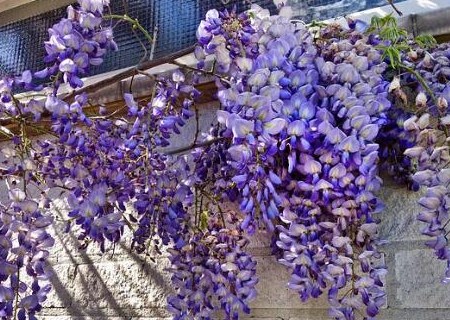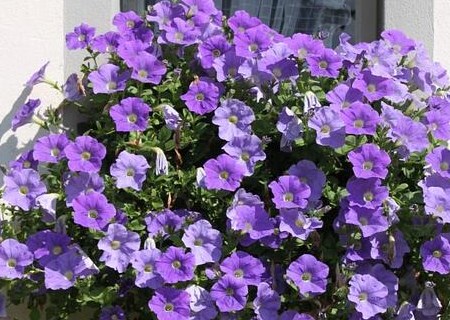What are the seed planting methods of wisteria (also known as rattan)? What if the leaves turn yellow and fall off? Why not blossom?
Wisteria has strong adaptability to the growing environment. Folk purple flowers or water blanch cold salad, or wrapped noodles fried, the production of "purple cake", "purple cake" and other flavor pasta, people like to grow wisteria. So do you know the methods of planting wisteria seeds? Why not blossom? What if the leaves turn yellow and fall off?

I. planting methods of wisteria seeds
Wisteria can propagate easily, such as sowing, cutting, striping, splitting, grafting and other methods, mainly sowing and cutting, but because of the long time required for seedling culture, cutting is the most widely used.
1. Cuttage propagation
Cuttings are usually propagated with hardwood cuttings. Before the shoots sprouted in the middle and last ten days of March, the sturdy branches of 1 ~ 2 years old were cut into 15cm cuttings and inserted into the seedbed prepared in advance, and the cutting depth was 2 × 3 of the cuttage length. Spray water after insertion, strengthen maintenance, keep the seedbed moist, the survival rate is very high, the plant height can reach 20~50cm in that year, and can be out of the nursery after two years.
The root cuttings are easy to produce adventitious buds on the root of wisteria. In the middle and last ten days of March, the thick root system of 0.5~2.0cm was dug, cut into cuttings with long 10~12cm length, and inserted into the seedbed, and the cutting depth was kept flat with the ground. Other management measures are planted in the same branch.
2. Sowing and reproduction
Sowing and reproduction is carried out in March. The seeds were harvested in November, peeled off, dried and bagged for storage. Soak the seeds in hot water before sowing. When the temperature of boiling water drops to about 30 ℃, fish out the seeds and rinse them in cold water for a while, then keep them moisturized for a day and night before sowing. Or store the seeds in wet sand and soak them in clean water for 1-2 days before sowing.
Striping, ramet and grafting were carried out in the middle and last ten days of March.
3. Cultivation and transplanting
More than planting in early spring, it is necessary to set up a frame before planting, and tie the coarse branches to the rack to make it climb along the shelf. Because of the long life of wisteria, thick branches and luxuriant leaves, the scaffolding material must be solid and durable. When young trees are first planted, the branches cannot form flower buds, and then there will be peanut buds. If planting for several years still does not blossom, first, because the tree is too prosperous, too many branches and leaves, second, the tree is weak, it is difficult to accumulate nutrients. The former adopts partial root cutting and thinning of branches and leaves, while the latter can blossom by adding fertilizer. More potash fertilizer should be applied appropriately. During the growing period, the middle branch can be cut short with 5-6 buds, and the weak branches can be cut off to promote flower bud formation.
It blossoms in March and blossoms in April, with 20-80 butterfly flowers in each axis. Wisteria likes sunshine and bears shade slightly. Because wisteria is a big vine, in order to make it grow well, it is generally set up a certain scaffolding for cultivation. Wisteria also has smaller species and varieties that can be used as potted plants or to make bonsai.
Why wisteria doesn't blossom
1. Cause analysis
(1) seedlings
The reason why wisteria does not blossom lies in the planting of seedlings, that is, seedlings cultivated by sowing. This kind of seedling usually takes 7 years to blossom, while normal grafted seedlings blossom within 3 years.
(2) improper pruning
Novice flower growers do not know how to prune, only cut off the branches that grow too fast, in fact, that is the reproductive branch. So in the process of pruning, don't cut it if you don't understand it, even if you have to cut off the dead branches and leaves first, and then ask for professional help.
(3) lack of light
Seedlings planted in the ground or pot should receive at least 6 hours of light. In the maintenance process, it will be affected by different planting or placement, weather conditions and other factors. Light can be supplied artificially if there are conditions.
(4) do not turn the basin and change the soil for a long time.
The soil contains a large number of trace elements, which is a necessary condition for root growth. When you do not turn the pot to change the soil for a long time, the elements in the soil are exhausted, and the plants lack the accumulation of nutrients, so it is difficult to blossom!
(5) varieties and other objective factors
There are many varieties of wisteria, some bloom less and some blossom late in the same conservation environment! These are uncontrollable factors, and how to blossom is related to your original choice.
The rest is for personal reasons, maintenance depends on luck, each watering and fertilization at the right time, will affect flowering!
2. Solution
(1) strengthen management and supplement nutrition
If the plant lacks nutrition and does not blossom due to improper maintenance, maintenance should be strengthened and topdressing for 2 or 3 times during the growing period to ensure the supply of nutrition. Turn the soil and change the basin at the right time to ensure that there are sufficient trace elements in the soil.
(2) choose excellent varieties of flowering.
Sometimes it's not your fault that you don't blossom, it's because the plant blossoms late or even doesn't blossom. Therefore, it is necessary to choose varieties that are easier to bloom and cultivate.
(3) reasonable pruning
Pruning should be based on the growth of the plant itself, grow too fast, and cut off the weak branches and withered branches in time. When the plant grows too slowly, don't prune it even if the time is right, so as not to affect the flowering.
Third, what if the leaves turn yellow and fall off?
1. Overwatering the young leaves on the top of the flowers are yellowish, the old leaves are gradually yellowing, and the new shoots are shrinking. This is due to long rain or too much watering, too wet in the basin, lack of oxygen in the soil, and root rot. The soil should be loosened often, watering should be controlled and heavy rain should be avoided.
2. The color of the leaves on the top of the soil is normal, and the lower leaves gradually dry yellow and fall off upward. This is due to the fact that the pan soil is too full or impermeable for a long time, resulting in the aging of the branches of the lower leaves, which should be watered appropriately to keep the soil moist.
3. Lack of fertilizer, the leaves of flowers are thin and yellow, which is due to the fact that the big pots of flowers are small or have not changed pots for a long time, change soil and lack of fertilizer, so water and fertilizer should be increased gradually and pots should be changed at the right time.
4. the leaves of fertilizer-damaged flowers are concave and convex, the new leaves are thickened and the old leaves are yellowing, so they should be watered frequently and fertilization should be suspended. Vegetable seeds can be sprinkled in the basin and pulled out after emergence to consume the fertilizer in the pot and restore the normal growth of flowers and trees.
5. The flowers and trees that are partial to alkali and like acid soil, the leaves turn yellow, which is caused by the alkalinity of the soil. The leaves will turn green if the grass is watered with soaking water and ferrous sulfate is applied.
6. when the light is not suitable, the potted flowers are often put indoors, and the flowers are easy to have yellow leaves. Those who like sunshine, such as lack of light, will also have yellow leaves. Some flowers that like a cool environment, such as high temperature exposure, their leaves will also turn yellow and fall off.
Time: 2019-03-17 Click:
- Prev

What are the seed planting methods of evergreen herbaceous plant Cymbidium? What if the leaves turn yellow? Can you put it in the bedroom?
Cymbidium, Monocotyledon, Aspartaceae, Cymbidium belongs to perennial evergreen herbs, Cymbidium likes warm, humid, semi-shady environment, strong adaptability, many people like to plant it, so what do you know about the seed planting methods of Cymbidium? What if the leaves turn yellow? Can you put it in the bedroom?
- Next

What are the seed planting methods of herbaceous vine big flower petunia? What's the value? When will it blossom?
Big flower petunias, alias white edge petunias, are mostly used for viewing, and some are used to collect flower seeds that can be used for medicinal purposes. It is also widely planted in China, so do you know about the seed planting methods of petunia? What's the value? When will it blossom? According to the research data of morning glory
Related
- Fuxing push coffee new agricultural production and marketing class: lack of small-scale processing plants
- Jujube rice field leisure farm deep ploughing Yilan for five years to create a space for organic food and play
- Nongyu Farm-A trial of organic papaya for brave women with advanced technology
- Four points for attention in the prevention and control of diseases and insect pests of edible fungi
- How to add nutrient solution to Edible Fungi
- Is there any good way to control edible fungus mites?
- Open Inoculation Technology of Edible Fungi
- Is there any clever way to use fertilizer for edible fungus in winter?
- What agents are used to kill the pathogens of edible fungi in the mushroom shed?
- Rapid drying of Edible Fungi

